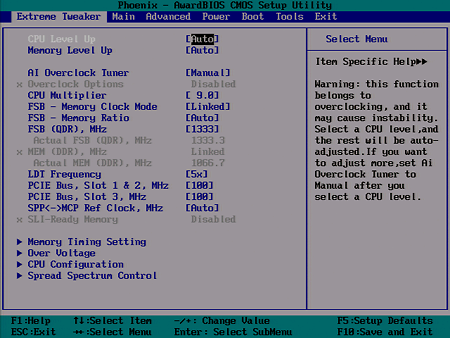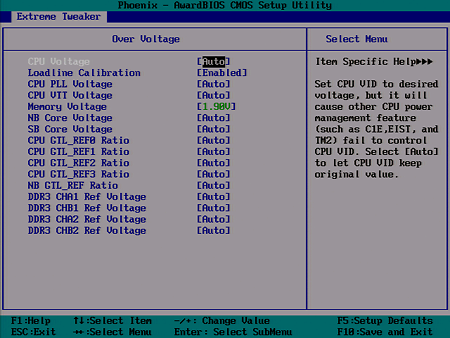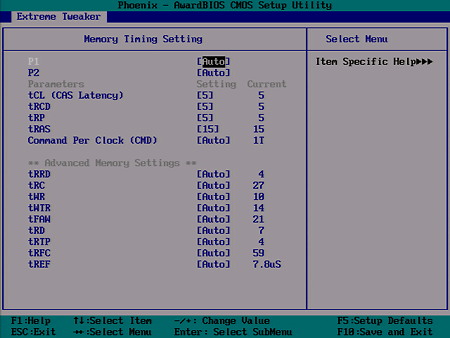790i Ultra SLI Motherboards Compared
BIOS and Overclocking
| FSB Data Rate | FSB-400 to FSB-3000 MHz (1 MHz) |
| Clock Multiplier Adjustment | Yes |
| DRAM Linked Ratios | Automatic, 1:1, 5:4, 3:2 |
| DRAM Unlinked Data Rate | DDR3-800 to DDR3-3000 |
| PCIe Clock | 100 to 200 MHz (1 MHz) |
| CPU Vcore | 1.1000 to 2.4000 Volts (0.00625 Volts) |
| CPU FSB Voltage | 1.20 to 2.46 Volts (0.02 Volts) |
| Northbridge (SPP) | 1.30 to 2.20 Volts (0.02 Volts) |
| Southbridge (MCP) | 1.50 to 1.85 Volts (0.05 Volts) |
| DRAM Voltage | 1.50 to 3.10 Volts (0.02 Volts) |
| CAS Latency Range | tCAS: 5-18; tRCD: 1-15; tRP: 1-15; tRAS: 1-63 |
FSB clocks of up to 750 MHz (FSB-3000) are encouraging, if not completely realistic. We’ve never seen an unmodified air-cooled Nvidia-based motherboard reach 500 MHz bus clock before, but we have high hopes for the 790i Ultra SLI.
For users not familiar with manual overclocking, the Striker II Extreme offers several “AI Overclock” adjustments. CPU Level Up can set the approximate speed of a higher-model processor automatically, while an “Overclock Options” menu that appears with the “AI Overclock” option enabled provides automatic speed increases of 5% to 20% in 5% increments.

The Striker II Extreme also provides an automatic memory overclocking option, but the highest setting for our PC3-12800 (DDR3-1600) was its rated PC3-12800 speed. The lack of further adjustment is likely a ruse on Nvidia’s part, where one must pay for the Nvidia logo on his or her RAM to enable “automatic overclocking”. True enthusiasts will know how to adjust their memory manually for the highest performance.
Like most Nvidia chipset LGA775 motherboards, the Striker II Extreme has several “linked” FSB to DRAM memory ratios, but only three of them — 1:1, 5:4, and 3:2 — are manually selectable. Other “linked” ratios can only be used via automatic detection, and setting other speeds manually requires “unlinking” the memory controller.

CPU Core Voltage adjustments up to 2.40 volts and DRAM voltages up to 3.10 volts are surely enough to fry any off-the-shelf part, but extreme overclockers will have a good idea of the limitations for their components. It’s certainly nice to see a wide range of settings, even if the limits are way up there.

All of the important memory settings feature broad enough latency ranges to extract optimum performance at any relevant DDR3 speed. Look for the memory performance and overclocking charts later in this article.
Get Tom's Hardware's best news and in-depth reviews, straight to your inbox.
-
Crashman This was ALL OF THE AVAILABLE 790i Ultra SLI MOTHERBOARDS: Other graphics brands with NVIDIA reference boards INCLUDING EVGA are selling the same unit as XFX, even with the same BIOS (except for the boot logo). XFX was the only one who cared to send one.Reply -
giovanni86 Thats what i was going to say!!! Thank god. Well i guess i made the right choice. XFX 790i, exactly what i am going to buy in the coming month. Just need to save for it XD.Reply -
jaragon13 Who would pay four hundred dollars,when you can just buy a P45 for 100-150 dollars which has roughly the same real world experience as an X48 or 790I?Reply
Nah,I'd rather buy better and more reliable parts-such as power supply,processor,GRAPHICS CARD,and maybe go buy a rifle :P -
kitsilencer $400 for a motherboard? What the hell is wrong with the X48 Express that people would rather consider buying a 790i? And it can't be because of SLI. Makes more sense to buy the X48 and Crossfire.Reply -
Crashman jaragon13Who would pay four hundred dollars,when you can just buy a P45 for 100-150 dollars which has roughly the same real world experience as an X48 or 790I?Nah,I'd rather buy better and more reliable parts-such as power supply,processor,GRAPHICS CARD,and maybe go buy a rifleReply
If you want SLI you're going to need an SLI motherboard. The article specifically stated that the reference design motherboard was almost as good in many ways as the winning board, but far cheaper.
The site only has two awards, one is for top value and the other is for "best of the best". It's hard to award a $350 motherboard for top value, but it's not so difficult awarding the "best of the best" even if the price is outrageous -
Crashman kitsilencer$400 for a motherboard? What the hell is wrong with the X48 Express that people would rather consider buying a 790i? And it can't be because of SLI. Makes more sense to buy the X48 and Crossfire.Reply
It does! Well, sorta. If you want the absolute fastest rig on the planet, you're going to need at least two, possibly three, GTX280's. But if you can wait a few days or maybe a couple weeks, you might be surprised at how well a Crossfire set of HD4870X2's can perform using an X48 motherboard. -
jaragon13 My point is that,even though you could theoritically have 3/4 GPU's all at once,you won't get nearly as much performance as you'd want.A simple 750I or P45 chipset will do nearly the same job.Reply -
zer00000 It is a foxconn board i bet.I just read a review elsewhere with same stuff except it had an x48 chipset."All manner of goodies are bundled with the Black Ops: a 120MM fan, a plastic dry ice cooling pot for the Northbridge, and a Plexiglas "benching table" for open-air use."Reply
